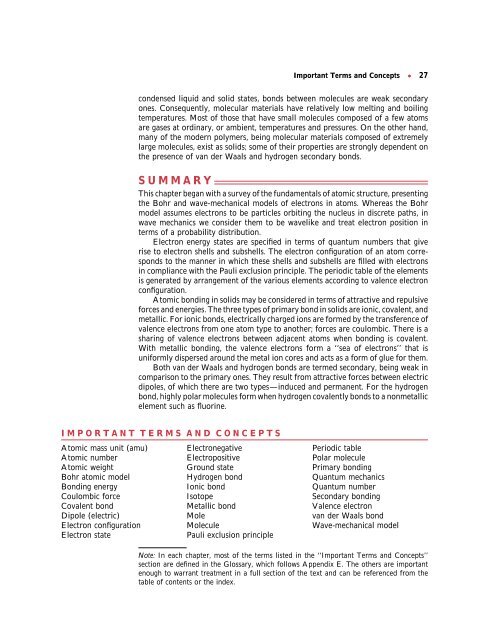Chapter 2 / Atomic Structure and Interatomic Bonding
Chapter 2 / Atomic Structure and Interatomic Bonding
Chapter 2 / Atomic Structure and Interatomic Bonding
Create successful ePaper yourself
Turn your PDF publications into a flip-book with our unique Google optimized e-Paper software.
Important Terms <strong>and</strong> Concepts ● 27<br />
condensed liquid <strong>and</strong> solid states, bonds between molecules are weak secondary<br />
ones. Consequently, molecular materials have relatively low melting <strong>and</strong> boiling<br />
temperatures. Most of those that have small molecules composed of a few atoms<br />
are gases at ordinary, or ambient, temperatures <strong>and</strong> pressures. On the other h<strong>and</strong>,<br />
many of the modern polymers, being molecular materials composed of extremely<br />
large molecules, exist as solids; some of their properties are strongly dependent on<br />
the presence of van der Waals <strong>and</strong> hydrogen secondary bonds.<br />
SUMMARY<br />
This chapter began with a survey of the fundamentals of atomic structure, presenting<br />
the Bohr <strong>and</strong> wave-mechanical models of electrons in atoms. Whereas the Bohr<br />
model assumes electrons to be particles orbiting the nucleus in discrete paths, in<br />
wave mechanics we consider them to be wavelike <strong>and</strong> treat electron position in<br />
terms of a probability distribution.<br />
Electron energy states are specified in terms of quantum numbers that give<br />
rise to electron shells <strong>and</strong> subshells. The electron configuration of an atom corresponds<br />
to the manner in which these shells <strong>and</strong> subshells are filled with electrons<br />
in compliance with the Pauli exclusion principle. The periodic table of the elements<br />
is generated by arrangement of the various elements according to valence electron<br />
configuration.<br />
<strong>Atomic</strong> bonding in solids may be considered in terms of attractive <strong>and</strong> repulsive<br />
forces <strong>and</strong> energies. The three types of primary bond in solids are ionic, covalent, <strong>and</strong><br />
metallic. For ionic bonds, electrically charged ions are formed by the transference of<br />
valence electrons from one atom type to another; forces are coulombic. There is a<br />
sharing of valence electrons between adjacent atoms when bonding is covalent.<br />
With metallic bonding, the valence electrons form a ‘‘sea of electrons’’ that is<br />
uniformly dispersed around the metal ion cores <strong>and</strong> acts as a form of glue for them.<br />
Both van der Waals <strong>and</strong> hydrogen bonds are termed secondary, being weak in<br />
comparison to the primary ones. They result from attractive forces between electric<br />
dipoles, of which there are two types—induced <strong>and</strong> permanent. For the hydrogen<br />
bond, highly polar molecules form when hydrogen covalently bonds to a nonmetallic<br />
element such as fluorine.<br />
IMPORTANT TERMS AND CONCEPTS<br />
<strong>Atomic</strong> mass unit (amu)<br />
<strong>Atomic</strong> number<br />
<strong>Atomic</strong> weight<br />
Bohr atomic model<br />
<strong>Bonding</strong> energy<br />
Coulombic force<br />
Covalent bond<br />
Dipole (electric)<br />
Electron configuration<br />
Electron state<br />
Electronegative<br />
Electropositive<br />
Ground state<br />
Hydrogen bond<br />
Ionic bond<br />
Isotope<br />
Metallic bond<br />
Mole<br />
Molecule<br />
Pauli exclusion principle<br />
Periodic table<br />
Polar molecule<br />
Primary bonding<br />
Quantum mechanics<br />
Quantum number<br />
Secondary bonding<br />
Valence electron<br />
van der Waals bond<br />
Wave-mechanical model<br />
Note: In each chapter, most of the terms listed in the ‘‘Important Terms <strong>and</strong> Concepts’’<br />
section are defined in the Glossary, which follows Appendix E. The others are important<br />
enough to warrant treatment in a full section of the text <strong>and</strong> can be referenced from the<br />
table of contents or the index.



